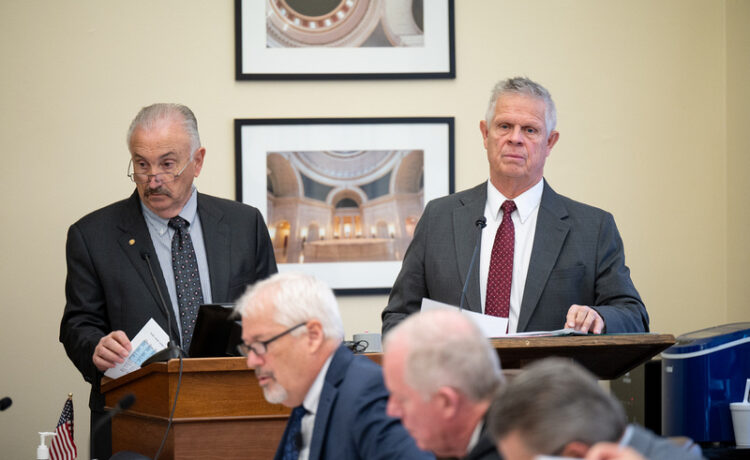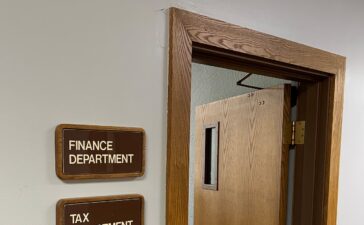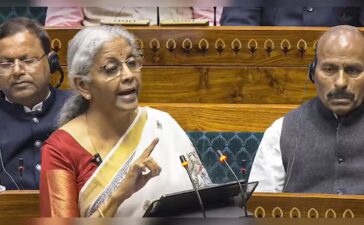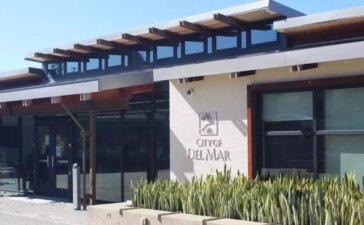Budget officials with the Morrisey administration spent the morning explaining their conclusion that the state has faced a budget gap of nearly $400 million, along with their methods for resolving it.
When it concluded the House Finance Committee chairman had a one word response about whether he was buying the rationale.

“No,” said Delegate Vernon Criss, R-Wood.
“I was not.”
That’s going to be an ongoing driver of the 60-day legislative session that just got started.
The Morrisey administration came into office last month, added up the numbers and determined a budget gap complicated by aggressive personal income tax cuts, fluid severance tax collections, millions of dollars of the state’s share of Medicaid costs, the ever-increasing cost of insurance for public employees and more.
The administration proposes to deal with that gap through an admittedly awkward blend of increased revenue estimates for non-tax sources like lottery dollars, paying for some ongoing costs through prior years’ leftover budget surplus dollars and through cuts that officials are describing as targeted.
Criss and other delegates on the House Finance Committee listened to a detailed explanation for an hour and a half on Thursday morning.
The chairman didn’t buy the premise, suggesting that the new administration’s method for calculating available dollars seemed backwards to him.
And he underscored the Legislature’s constitutional role in actually allocating the money. Bottom line, when 60-days is up, the budget that goes out the door could be very different from the one that’s being proposed on the front end.
“It is up to me as chairman of Finance to propose a budget, and it is our year to propose the budget first. And we will do our budget and propose it to the House at the appropriate time,” Criss said in a post-meeting interview in his office.
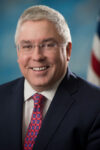
Gov. Patrick Morrisey gave his first State of the State address on Wednesday evening before lawmakers from both chambers as the House Speaker and Senate President sat behind him. The administration is proposing a $5.323 billion general revenue budget. That’s just a smidge higher than last year.
The House Finance chairman said today, “His budget that he presented to the speaker and to the president last night and to the explanation of how they want to spend their money is their opinion.”
Morrisey’s administration has projected a $397 million deficit for the coming fiscal year. Morrisey has said his administration has identified several drivers of a potential budget deficit, which they say will be filled.
The highest figure is a $153 million shortfall on the state’s share of Medicaid spending. Next is $62 million to the state’s share of expenses related to the Public Employees Insurance Agency. And Morrisey has described big expenses for education, corrections, public defenders and tourism.
Morrisey has said $47 million needed right away to fund Division of Corrections and Rehabilitation though June.
Morrisey has described an additional financial pressure, saying additional personal income tax cuts that the state took on this year don’t match with the spending demands. The governor has said he supports tax cuts, but he said the state took on the latest round without identifying a way to cover budget demands.
The administration’s budget director, Mike McKown, presented many of the details to the House Finance Committee. He would later make the same presentation to the Senate Finance Committee. McKown said when the new administration came into office, they quickly identified a “structural gap” and worked to close it.
He said expenses added up to $6.1 billion at the start — yet projected revenue added up only to $5.7 billion.
McKown went into detail about some maneuvers to close the gap — including raising estimates for some non-tax revenue items, like lottery dollars. That also included moving some ongoing costs to use surplus funding from prior years’ general revenue surplus — about $171 million in one-time dollars.
And the administration’s budget proposal reflects about $109 million in base cuts, McKown told delegates. There is no pay raise for teachers in this budget, but an extended outlook reflects 3% raises in coming years.
“Not the perfect way to do it, but it solved the ’26 gap,” McKown said.
In his own comments, Criss said the process essentially looked backwards from what he thinks it should be. He said a better way would be first determining one-time spending items. Those, then would not be included in ongoing spending obligations.
He said that would especially be a useful system if hard times hit.
“If you keep that base low and you have the one time items in the back of the budget, then you are able to immediately not have to fund those things in the back of the budget, because you don’t have the funds available,” he said. “And then your government is able to continue to provide the services at the base budget that you have.”

Delegate John Williams, D-Monongalia, is the minority chairman of the House Finance Committee.
Williams said officials should have seen this coming. The state’s budget situation benefited from covid relief dollars and federal infrastructure activity over the past few years. And at the same time, West Virginia dove deep into personal income tax cuts while taking on other additional expenses.
“I think there’s some creative speak happening. I think the underlying question is, which administration do you trust, the one that was in office just last month, or this one,” Williams said.
“We voted on massive tax cut bills over the past year and a half” Williams said. “I think we saw this coming, that this is going to create terrible problems for future out years, and here we’ve come home to roost, and we have that problem.”

